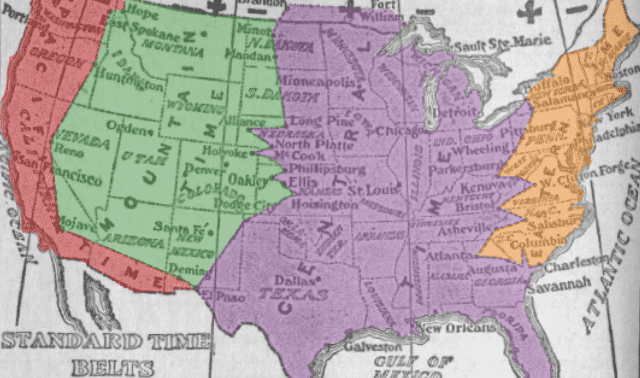
Does anybody really know what time it is? For our ancestors, the answer depended on where they were, with each town’s official clock—typically on a church or city hall—set by the sun, which would be overhead at noon each day. Estimates of the number of these local “time zones” range from 300 to 8,000 across the United States alone. “Sun time” differs by four minutes for every degree of longitude, making New York and Boston eight minutes apart.
When your clocks “spring forward” or “fall back” with Daylight Saving Time, take a moment to observe the birthday of America’s standard time zones. On Nov. 18, 1883—the “day with two noons”—most places in the continental United States adopted the system of four time zones originally known as Standard Railway Time. The railroads had been struggling with 100 different local time zones of their own devising. This inconsistency was the impetus for standardization, made possible by the telegraph.
Another mode of transportation—the sailing ship—inspired the earliest efforts to standardize time. The Royal Observatory in Greenwich, England, established Greenwich Mean Time (GMT) in 1675 as an aid to mariners in determining longitude. In 1764, John Harrison perfected the use of clocks to determine a ship’s east-west position at sea. Each town in England, however, continued to set its own clocks by the sun.
How Railroads Created Time Zones
England’s railroads also needed standardization for their timetables. In 1840, the Great Western Railway became the first to adopt London time, and most railroads soon followed suit. In 1847, the Railway Clearing House recommended switching to GMT. The Royal Observatory transmitted its first telegraph signal for setting clocks on August 23, 1852, and by the mid-1850s, most public clocks in Britain were set to GMT. A few holdouts used a pair of minute hands—one for local time, the other for GMT—and the legal and electoral system followed local “sun time” until 1880.
In the United States, amateur astronomer William Lambert lobbied Congress for time standardization as early as 1809. The idea didn’t gain traction until 1869, when Charles Ferdinand Dowd drew up a plan for “Railway Time.” Dowd ran a school for girls in Saratoga Springs, NY, and developed his ideas as a teacher posing problems to students. Initially, he proposed a single, nationwide time zone based on the time in Washington, DC, similar to England’s GMT. But the vastness of the United States made that impractical, so in 1872 he revised his scheme to create four sections set off by an hour, similar to those used today. Despite being ratified by a group of railroad managers, Dowd’s plan stalled.
The need for standardized time grew more urgent with the expansion of the railroads. When the Golden Spike completed the Transcontinental Railroad in 1869—the same year Dowd proposed his initial plan—the time was 12:45 p.m. at the site in Promontory Point, Utah; but 12:30 p.m. in Virginia City, Nev.; 11:44 a.m. in San Francisco; and 2:47 p.m. in Washington, DC. The railways’ 53,000 miles of tracks operated according to at least 80 different timetables.
Time Zones Come to the US
A Scottish-born Canadian railway engineer, Sir Sandford Fleming, led the next push for standardizing time not only in North America, but also around the world. In 1878, he published “Terrestrial Time,” a pamphlet that set out a plan similar to Dowd’s and advocating for global time standardization. He cited the problem of a steamship traveler from Britain arriving in America and transferring to a train. How, Fleming reasoned, could such a traveler know what time to catch his train?
Fleming’s proposal also might have languished if not for William F. Allen, another railroad engineer and editor of the Official Guide to Railways. Allen became a crusader for standardized time, traveling the continent to drum up support. Another booster, Cleveland Abbe, the first head of the US Weather Bureau, put his weight behind standard time and enlisted the American Meteorological Society. That society’s 1879 “Report on Standard Time” helped push the railroad companies to institute a version of Fleming’s plan in 1883.
The following year, under Fleming’s leadership, the International Prime Meridian Conference met in Washington, DC. The conference agreed on Greenwich as the “prime” (zero degrees) meridian from which 24 international time zones would be calculated. Each zone represented 15 degrees of longitude and one hour of time.
American adherence to the new time zones remained voluntary, and a few places resisted. Detroit, about halfway between the meridians for Eastern and Central time, stuck with local time until 1900, tried Central time for awhile, then by popular vote adopted Eastern time in 1916.
The Standard Time Act of 1918
US time zones weren’t mandatory until March 19, 1918, when Congress passed the Standard Time Act, stating that the Interstate Commerce Commission would regulate time zones (taken over by the new Department of Transportation in 1966). Even so, the boundaries and number of zones across the continent have been fluid. Alaska was originally split into four time zones, but in 1983, with the exception of the westernmost Aleutian Islands, the state switched to a single Alaska Standard Time zone. Time zone lines have moved slightly westward since 1918, too, as places on eastern edges jump to the adjacent zone in search of an extra hour of daylight in the evening.
That 1918 act also gave all Americans an extra hour of evening daylight by instituting the nation’s first daylight saving time. The controversial wartime measure was repealed the next year, then reinstituted year-round as “War Time” during World War II, and finally standardized by the Uniform Time Act of 1966. Loopholes still let states and localities opt out: Arizona, Hawaii and several US territories don’t observe daylight saving time.
Today, the United States and its territories encompass nine standard time zones in Coordinated Universal Time (UTC), the successor to GMT. These nine zones range from UTC minus four hours to UTC minus 11 hours, as well as UTC plus 10 hours in the Pacific.
US Time Zones History Fun Facts
- Nepal was the last country to adopt a standard time based on GMT (plus 5 hours, 45 minutes), in 1986.
- Not all countries embraced standard time zones with even hours based on GMT. Several, including India, Iran, Afghanistan, Myanmar, Sri Lanka, Venezuela and parts of Australia, use half-hour deviations, while a few use quarter-hour differences.
- China is the largest country with a single time zone; until the Communist takeover in 1949, it spanned five zones. France, with its islands in the Caribbean and Pacific and its jurisdiction over Guiana in South America, has the most time zones, with 12.
- Before standardization of daylight saving time in 1966, bus drivers on a 35-mile stretch of Route 2 between Moundsville, WV, and Steubenville, Ohio, had to reset their watches seven times.
Time Zones History Timeline
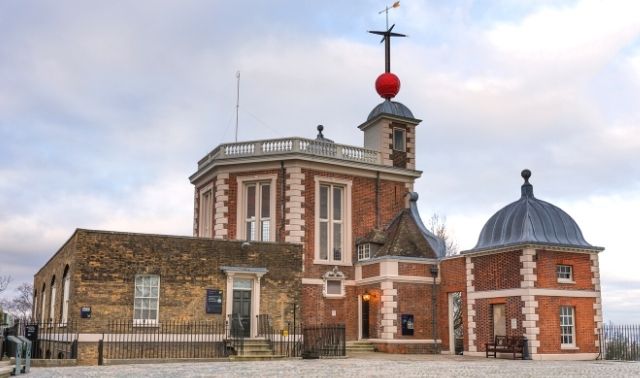
Royal Observatory is built in Greenwich
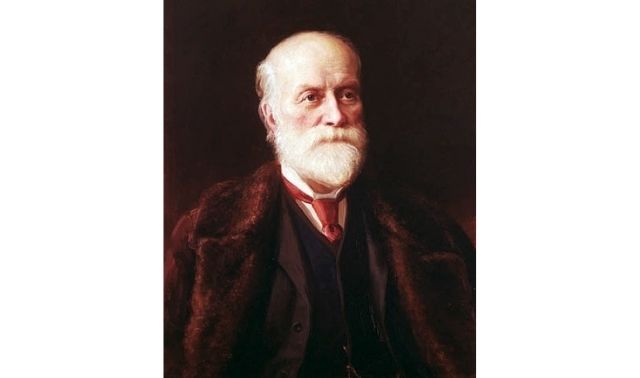
Sir Sandford Fleming proposes a worldwide system of time zones
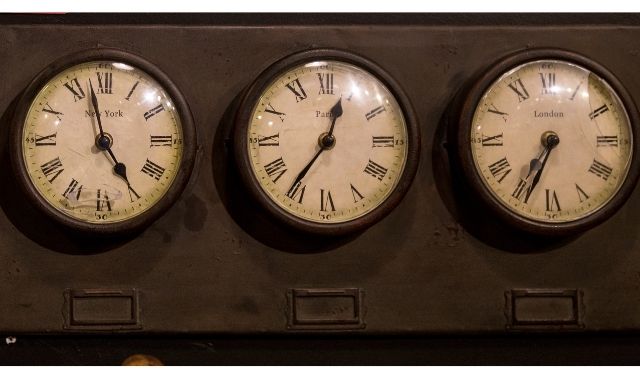
Greenwich Mean Time becomes Britain’s official time

US railways adopt standard time zones
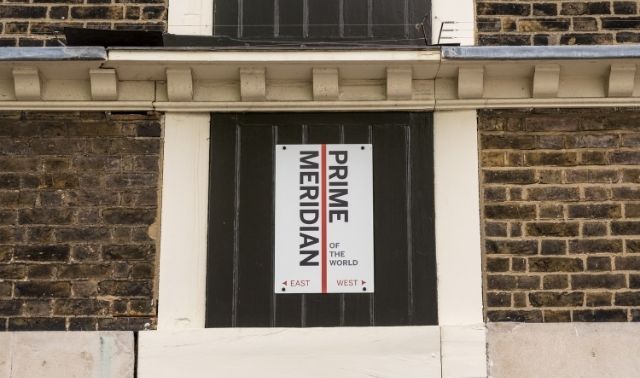
International Prime Meridian Conference selects Greenwich as the standard for zero degrees longitude
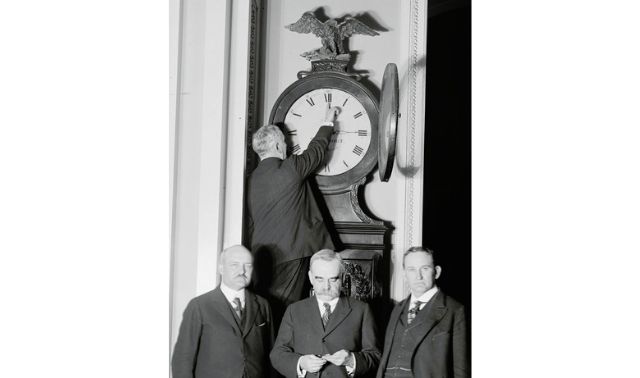
Congress passes the
Standard Time Act
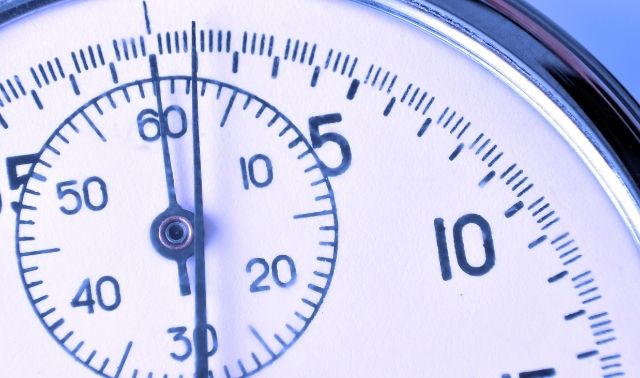
“Leap second” is introduced to account for Earth’s slowing rotation
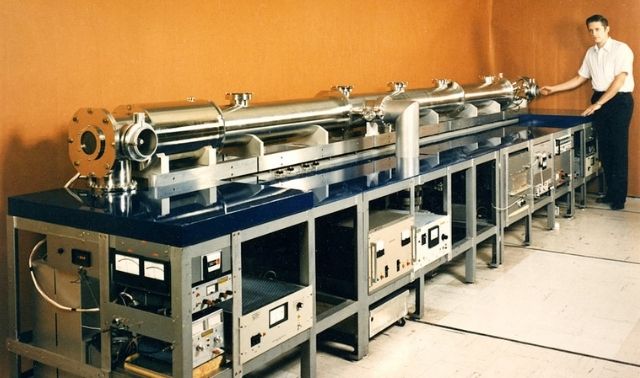
Official standard switches from GMT to the Coordinated Universal Time
atomic clock system
A version of this article appeared in the October/November 2014 issue of Family Tree Magazine.
No comments:
Post a Comment